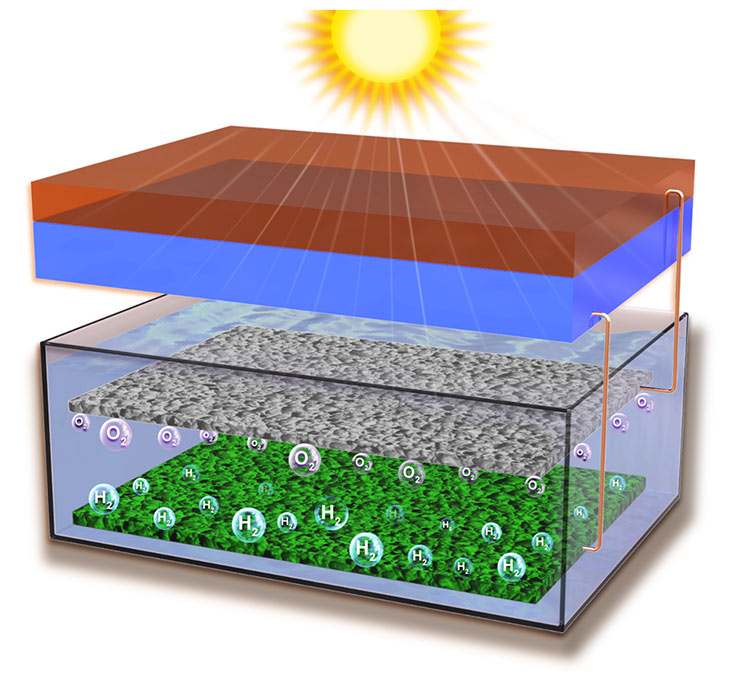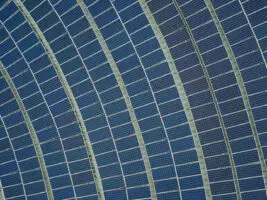A team of Australian researchers has set a new world efficiency record for the direct production of renewable hydrogen from solar energy using low-cost materials, combining Australian-grown innovations in next-generation solar cells and electrolysis.
The milestone has been achieved by researchers from the Australian National University and the University of New South Wales, and is being hailed a major step towards slashing the cost of renewable hydrogen production.
The research has been published in the journal Advanced Energy Materials and details how the researchers used leading innovations in next-generation ‘tandem’ solar cells, combined with advances in electrolysis techniques to achieve a solar-to-hydrogen conversion efficiency of greater than 20 per cent.
The researchers used low cost silicon-perovskite ‘tandem’ solar cells optimised for the production of hydrogen, which combined two types of solar cells layered on top of each other to achieve a combined efficiency of 24.3 per cent – an efficiency higher than most conventional silicon solar cells.
The team then combined the high-efficiency tandem solar cells with low-cost catalyst materials to split water into hydrogen and oxygen through electrolysis. By drawing upon low-cost materials to produce the direct solar-to-hydrogen device, the researchers were able to achieve a conversion efficiency of greater than 20 per cent.
The researchers said that they had been able to achieve a conversion efficiency target set by the United State’s Department of Energy as part of efforts to reduce the production cost of renewable hydrogen.
The team is also confident that further research could ultimately beat the Morrison government’s target of producing hydrogen at a cost below $2 per kilogram.
“High efficiency direct solar water splitting systems made of low-cost light-absorbers and catalysts are a promising pathway to enable commercialisation of solar hydrogen technologies,” the research paper says.
“We have demonstrated a direct solar water splitting system with 20% [solar-to-hydrogen] efficiency by coupling earth-abundant catalyst electrodes with high-performance perovskite-Si tandem cells, fulfilling the [solar-to-hydrogen] efficiency target set by the DOE for the year 2020.”
While the current cost of hydrogen production makes it uncompetitive for a range of uses, particularly those related to use in the energy system – rapidly falling costs could see hydrogen become an affordable alternative to many fossil fuel derived sources, including transport fuels and energy used as a source of industrial heat.

Research co-author Dr Siva Karuturi of the Australian National University told RenewEconomy that by combining solar cells with hydrogen electrolysers into a single unit, improvements in production efficiency and reductions in cost could be achieved far beyond current renewable hydrogen production techniques.
“In a centralised electrolyser which usually runs on grid electricity, membrane and electrodes are stacked in multiple numbers – often hundreds of them – to achieve the desired production capacity which results in a complex system,” Dr Karuturi said.
“In direct PV-electrolysis, as demonstrated in our work, a single unit of electrodes and membrane can be directly integrated with PV cells into a simplified solar hydrogen module. This approach eliminates the need for power infrastructure and electrolysers, and thus can result in higher power conversion efficiency and low cost.”
The team is already hopeful of increasing this efficiency to 25 per cent by making improvements to the design and drawing upon further advances in tandem solar cell designs – and estimate that this could lower the cost of renewable hydrogen production to $2.30 per kilogram.
“The challenge lies in finding an optimum combination of PV and catalysts that enables high solar-to-hydrogen conversion efficiency,” Dr Karuturi said.
“The energy generated by PV cells should match that needed by catalyst electrodes. In addition, we need to do this using materials that are not expensive to scale. Our work employed perovskite/Si tandem PV cells and Ni-based catalysts that very well satisfy this criteria.”
The research team said that the strong results show the potential for combining innovations in solar and hydrogen production technologies to produce low cost renewable hydrogen, and expect that this could play a significant role in the decarbonisation of the broader energy system.
“Hydrogen has a critical role to play in our effort towards transitioning to net zero emissions by 2050. If we have to meet the expected demand for green hydrogen in the coming years and at a competitive cost, we need disruptive approaches. Direct solar hydrogen production has great potential,” Dr Karuturi said.
“Our future work focuses on scaling up and further improvement of the performance and robustness of the system.”
The research has been supported by funding provided by the Australian Research Council and the Australian Renewable Energy Agency.







